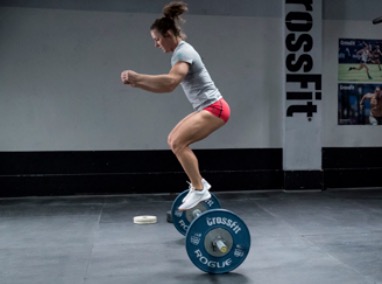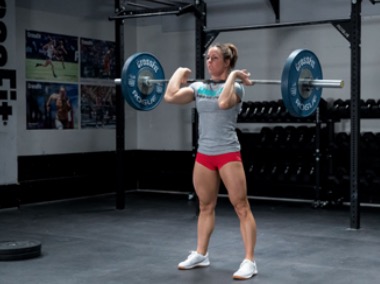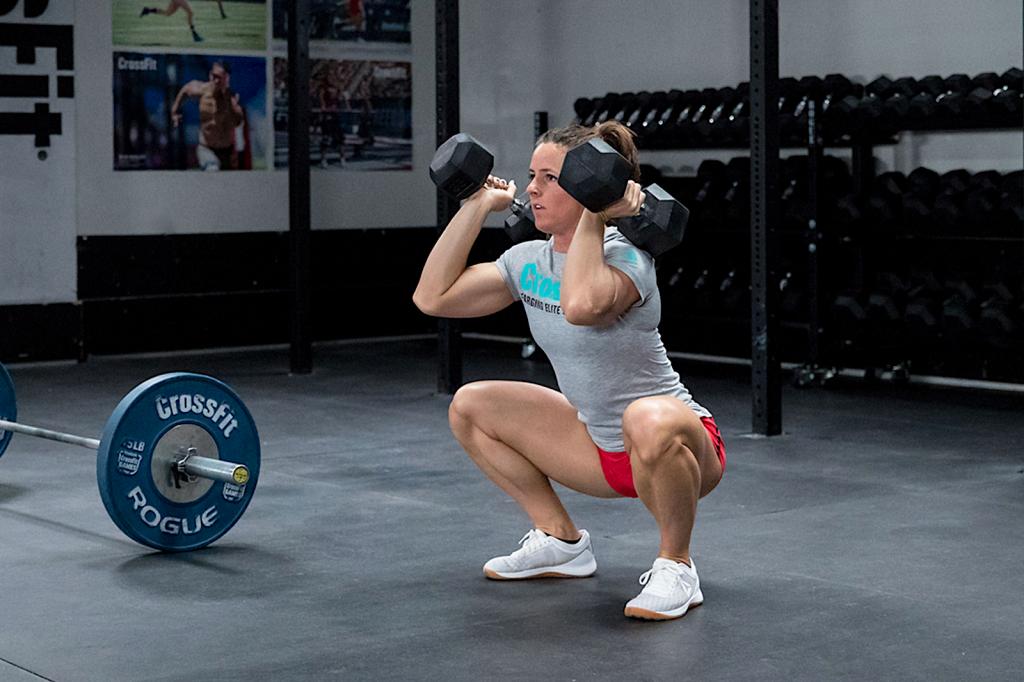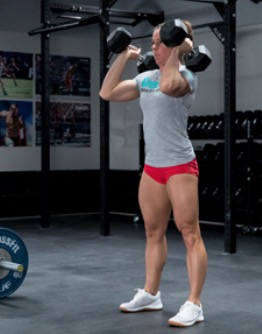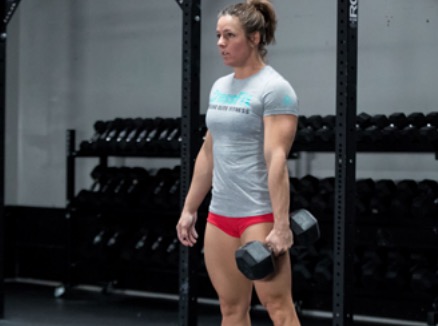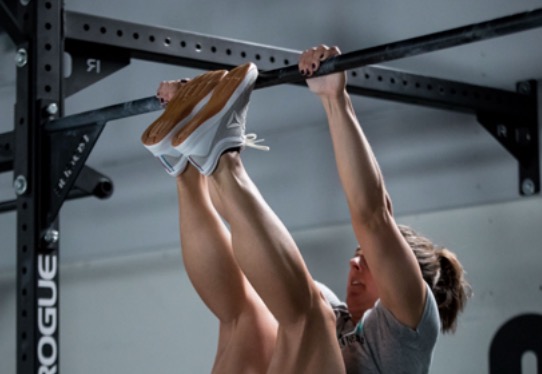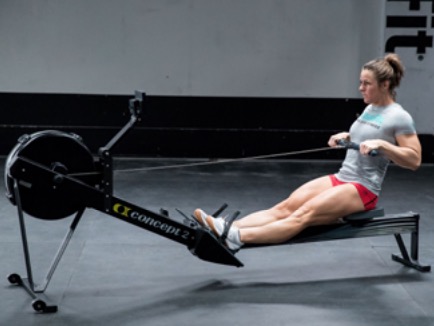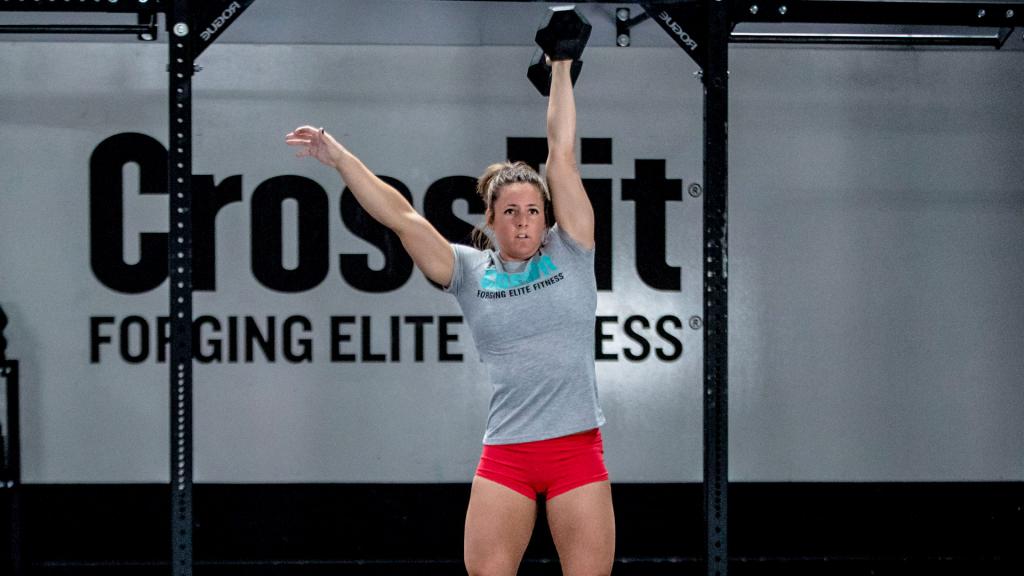18.2 Standards/Tips/Pointers
What was long and grueling in 18.1 is fast, spicy, and becomes heavy in 18.2!
Workout 18.2
1-2-3-4-5-6-7-8-9-10 reps for time of:
Dumbbell squats
Bar-facing burpees
and
Workout 18.2a
1-rep-max clean
*12 Minute Total Time-Cap*
Rx’d: (Ages 16-54) Men use 50-lb. dumbbells Women use 35-lb. dumbbells
Scaled: (Ages 16-54) Men use 35-lb. dumbbells, stepping burpees allowed Women use 20-lb. dumbbells, stepping burpees allowed
Masters 55+: Men use 35-lb. dumbbells Women use 20-lb. dumbbells
Scaled Masters 55+: Men use 20-lb. dumbbells, jump over empty barbell, stepping burpees allowed Women use 10-lb. dumbbells, jump over empty barbell, stepping burpees allowed
Tips and Pointers
- Spend a decent amount of time on your warm-up reviewing both movements for the couplet portion of this workout and warming up your clean to a relatively heavy weight.
- You want to go hard on the early portion of this workout, but not fast enough that you burn out. You need gas left in the tank for the rounds of 8,9, and 10... and then also for the clean.
- Set your barbell to a weight you know you can comfortably hit within one minute of finishing the squat/burpee portion of this workout.
Movement Standards
It is EXTREMELY important that all athletes and judges read this section to be sure that proper movement patterns are being enforced. In bold are a few to pay particular attention to:
- The rep begins from the top, with knees and hips extended and dumbbells on the shoulders. A muscle clean into a squat is allowed. The dumbbells must be held on the shoulders. There is no requirement to maintain a grip on the dumbbell the entire time. A squat clean is not allowed for first rep.
- The burpee must be performed perpendicular to and facing the barbell.
- The athlete will jump the feet back so that he or she is lying on the ground. The athlete’s head cannot be over the barbell. The chest and thighs touch the ground at the bottom.
- The athlete must jump over the barbell from both feet and land on both feet. Single-legged jumping or stepping over is not permitted (scaled divisions excluded). The barbell must be loaded with standard-height bumper plates for the athlete to jump over (scaled masters excluded).
- Using a two-foot jump, the feet must move back and forth together in the burpee.
- NOTE: Unless the athlete is performing the workout scaled, he or she may NOT step backward or forward one foot at a time when lowering and raising to and from the ground. On the way down, the athlete must jump both feet back simultaneously. On the way up, the athlete must jump both feet forward simultaneously. Stepping back and/or stepping up is permitted for athletes in the scaled divisions only. Scaled athletes may also choose to step over the barbell instead of jumping.
- The rep is complete when the athlete’s hips and knees are fully extended and the bar is resting on the shoulders in the front-rack position with the athlete’s elbows in front of the bar. Power cleans, squat cleans and split cleans are permitted. Hang cleans are not permitted.
Join us at 6am, 9am, or for "Friday Night Lights" from 4:30-7:30pm! Feel free to bring dinner, a snack, or a drink and hang out for the evening.
Most importantly... Have fun and enjoy yourself!! This is only Week 2 of the 2018 CrossFit Games Open. Cheer on your OVC community and do your best!
Welcome to #18POINT2!
3.2.18
Workout 18.2
1-2-3-4-5-6-7-8-9-10 reps for time of:
Dumbbell squats
Bar-facing burpees
and
Workout 18.2a
1-rep-max clean
*12 Minute Total Time-Cap*
Rx’d: (Ages 16-54) Men use 50-lb. dumbbells Women use 35-lb. dumbbells
Scaled: (Ages 16-54) Men use 35-lb. dumbbells, stepping burpees allowed Women use 20-lb. dumbbells, stepping burpees allowed
Masters 55+: Men use 35-lb. dumbbells Women use 20-lb. dumbbells
Scaled Masters 55+: Men use 20-lb. dumbbells, jump over empty barbell, stepping burpees allowed Women use 10-lb. dumbbells, jump over empty barbell, stepping burpees allowed
18.1 Standards/Tips/Pointers
Holy grip Batman!
Open Workout 18.1 is an exciting but long 20 minute triplet that will leave you staring at your hands wondering what happened. The best part though is that it is a workout that will be fun and exciting for everyone within our community to complete.
WORKOUT 18.1
Complete as many rounds as possible in 20 minutes of:
8 toes-to-bars
10 dumbbell hang clean and jerks
14 / 12-cal. row
Rx’d: (Ages 16-54) Men use 50-lb. dumbbell Women use 35-lb. dumbbell
Scaled: (Ages 16-54) Men perform hanging knee-raises, use 35-lb. dumbbell Women perform hanging knee-raises, use 20-lb. dumbbell
Masters 55+: Men use 35-lb. dumbbell Women use 20-lb. dumbbell
Scaled Masters 55+: Men perform sit-ups, use 20-lb. dumbbell Women perform sit-ups, use 10-lb. dumbbell
Tips and Pointers
- Just have singles for T2B? No problem! This is the perfect workout to test how far you can push yourself.
- Regardless of what movement or ability level you are at for the rig work, be sure to setup where you want using tape, wod wax, etc... then come up with a manageable plan for reps based on what you know you are capable of. Be smart, this is a long one!
- Take time during your warm-up to both review and practice the dumbbell clean and jerk standard. Most athletes should be able to go 5 and 5 on each arm but you don't want to exert more energy than needed to complete this movement.
- Have your rower setup and be ready to hop on when finished with the dumbbell. Don't rest... You can do that by controlling your row speed. Also, don't waste time messing with dampers, screens, and foot straps the whole workout. Be efficient so that you can maximize your strength on the row itself.
- Last but not least... It's the Open. Go hard, but pace yourself. Be smart until you get a feel for the workout and then begin to push and ask your body for more. Your brain will give up long before your body.
Movement Standards
It is EXTREMELY important that all athletes and judges read this section to be sure that proper movement patterns are being enforced. In bold are a few to pay particular attention to:
- In the toes-to-bar, the athlete must go from a full hang to having the toes touch the pull-up bar. At the start of each rep, the arms must be fully extended with the feet off the ground, and the feet must be brought back behind the bar and the rest of the body. An overhand, underhand or split-grip are all permitted.
- Both feet must come into contact with the bar at the same time, inside the hands.
- Athletes may wrap tape around the pull-up bar OR wear hand protection (gymnastics-style grips, gloves, etc.), but they may not tape the bar AND wear hand protection.
- After the dumbbell is lifted off the floor, the athlete must pause with the dumbbell at the hang position, either at his or her side or between the legs.
- From there, the athlete may perform a muscle clean, power clean, squat clean or split clean, so long as the dumbbell comes up and makes contact with the shoulder before being lifted overhead.
- Once at the shoulder, the athlete may get the dumbbell overhead any way he or she chooses. Shoulder press, push press, push jerk and split jerk are all permitted.
- The non-working hand may not come into contact with the body or the dumbbell while the dumbbell is being lifted.
- Athletes may use two hands while lowering the dumbbell between reps.
- At the top, the arm, hips and knees must be fully locked out with the dumbbell clearly over the middle of the athlete’s body when viewed from profile. Once the athlete has reached lockout, the repetition will count. If a split jerk is performed, both feet must return and be in line under the athlete’s body while the dumbbell is locked out overhead.
- Each round, athletes must perform 5 repetitions on one arm, then switch and perform the next 5 with the other arm.
- The monitor on the rower must be set to zero at the beginning of each row. The athlete or the judge may reset the monitor. The athlete must stay seated on the rower until the monitor reads 14 / 12 calories.
- In the hanging knee-raise, the arms and hips must be fully extended at the bottom with the feet off the ground, and the feet must be brought back behind the bar and the rest of the body. An overhand, underhand or splitgrip are all permitted. At the top, the athlete will raise his or her torso so the chest is upright and the hands touch the toes or the dumbbells.
Join us at 6am, 9am, or for "Friday Night Lights" from 4:30-7:30pm! OVC OPEN Performance Challenge Participants - Don't forget to bring a snack for bonus points.
Not registered yet? Get to Games.CrossFit.com ASAP and Sign-Up!
Most importantly... Have fun and enjoy yourself!! This is just start to the 2018 CrossFit Games Open and we have five weeks ahead of us. Cheer on your OVC community and do your best!
Welcome to #THEOPEN!
2.23.18
WORKOUT 18.1
Complete as many rounds as possible in 20 minutes of:
8 toes-to-bars
10 dumbbell hang clean and jerks
14 / 12-cal. row
Rx’d: (Ages 16-54) Men use 50-lb. dumbbell Women use 35-lb. dumbbell
Scaled: (Ages 16-54) Men perform hanging knee-raises, use 35-lb. dumbbell Women perform hanging knee-raises, use 20-lb. dumbbell
Teenagers 14-15: Boys use 35-lb. dumbbell Girls use 20-lb. dumbbell
Scaled Teenagers 14-15: Boys perform hanging knee-raises, use 20-lb. dumbbell Girls perform hanging knee-raises, use 10-lb. dumbbell
Masters 55+: Men use 35-lb. dumbbell Women use 20-lb. dumbbell
Scaled Masters 55+: Men perform sit-ups, use 20-lb. dumbbell Women perform sit-ups, use 10-lb. dumbbell
The Shocking, Un-Sugar Coated Truth about Sugar
The OV “Open” Performance Challenge is in full swing and we have been seeing the gym packed with members working towards their goals and completing additional challenges. We had previously touched on both the importance of and how to approach the nutrition aspect of this challenge. Hopefully this helped to point you in the right direction. This week we would like to dive into the not so sweet issues with sugar. If you are finding that making big changes to your diet is difficult or that you’ve switched to a different way of eating but are still feeling like you are lacking energy and are looking for a bigger change, maybe its time to get familiar with what sugar is really doing to your body.
Sugar has been making headlines everywhere for quite some time. Spend a little time researching online and you will see it referred to as toxic, addictive and labeled as the underlying cause of many diseases. Can sugar really be that bad for you? Well, the truth is that added sugar can have a negative head-to-toe impact on the human body. The sugar industry has actively fought to change public opinion about the health effects of sugar. However, today we know that sugar impacts just about every organ system in the body and not in a good way.
Lets quickly dive into some of the facts and a little bit of the latest science on what sugar is really doing to your body.
Some quick facts to familiarize yourself:
Refined sugar (ie. table sugar, white sugar) is a carbohydrate known as sucrose that is made up of two smaller carbohydrates: fructose and glucose.
Examples of added sugar include white sugar, brown sugar, raw sugar, corn syrup, corn syrup solids, high fructose corn syrup, malt syrup, maple syrup, pancake syrup, fructose sweetener, liquid fructose, honey, molasses, anhydrous dextrose, crystal dextrose and dextrin.
Refined sugar has no nutritional value and is empty calories.
Brown sugar is white sugar with brown coloring added either in the form of burnt sugar or molasses.
Fruit sugar, also called fructose, is a nutrient that is a naturally occurring in fruits and some vegetables.
Most carbohydrates are broken down into glucose – the sugar your body uses to form energy. It either becomes stored energy in your muscles and liver, or your body uses it immediately.
Sugar is actually addictive. When consumed it releases an opiate-like substance that our brain perceives as a reward, encouraging our body to want more.
4 grams of carbs is equal to 1 teaspoon of sugar
The average American consumes 22 teaspoons of sugar a day and the average child consumes 32 teaspoons.
Carbonated soft drinks are the leading source of refined sugar in the American diet.
Sugar overload can obstruct your taste buds from evolving thus making accepting bitter greens etc. much more difficult.
Now let’s take a look at the top ways added sugar is destroying your body:
Increased sugar consumption is one of the leading causes of degenerative disease.
It makes the digestive system acidic, which leaches vitamins and minerals from the body, particularly calcium from bones and teeth. It will also deplete potassium and magnesium which are both essential for cardiac health.
Sugar suppresses the immune system and causes an overproduction of digestive enzymes. In turn, this puts stress on your pancreas.
It impairs liver function, which can lead to high blood pressure, skin issues, and acne.
It inhibits blood flow and affects aging contributing to dental issues, wrinkles and dry, aged skin.
Non-alcoholic fatty liver disease is on the rise in the U.S and sugar is largely to blame due to the high fructose corn syrup in drinks and processed foods. Tuft University researchers discovered people who drink JUST ONE sugar-sweetened beverage a day face a higher risk of non-alcoholic fatty liver disease compared to those who steer clear of beverages containing added sugars.
Research is starting to show that added sugars appear to increase the risk of breast cancer and metastasis to the lungs
Sugar changes the gut microbiota in a way that increases intestinal permeability leading to diseases like leaky gut.
So, the bottom line is that sugar can be scary. Does this mean you should eliminate all sugar/ added sugars from your diet? Saying yes would be both untruthful and probably scary. The truth is that because of the effect has on your brain, it is not always that easy. Brain scans after sugar consumption are remarkably similar to brain scans after you do cocaine. Dopamine floods the brain, making the body feel good. This makes beating the sugar habit a bit harder. However, that doesn’t mean you can’t make big changes.
Both during and after this challenge, regardless of the nutritional path you have chosen you will see more physical results and benefit from granting your body better overall, long-term health if you become significantly more conscious of your sugar consumption.
You can do this by ensuring that you do the following:
If you do use sugar, use less processed forms, but use them sparingly. Maple syrup, honey, coconut sugar, raw cane sugar and potentially Stevia would fall into this category.
Avoid packaged/processed foods at all costs. Even the protein bars, protein shakes, yogurts, store bought oatmeal, and many products marketed towards athletes are packed full of unnecessary amounts of sugar.
If you are using a system such as counting macronutrients, do NOT use this as an excuse to eat unhealthy packaged, processed foods just to hit your numbers. You would bedoing your body a serious disservice.
Avoid High Fructose Corn Syrup at all costs. This is a sure way to know that a food product is cheap. It is directly correlated to fatty liver disease and cutting this out of your diet, along with soda are some of the best possible things you can do for your overall health.
Instead of buying flavored foods, always flavor them yourself. Buy things like plain yogurt and oatmeal and add your own toppings.
The best thing you can do is be aware. Check the food labels of all of the products you are buying and read the ALL the ingredients. A helpful hint is that the closer to the top of the ingredient list an ingredient is the more of it the product contains. Ensure that you are getting enough high-quality protein, fiber and fermented foods to help lose your sugar cravings over time. When you are craving something sweet reach for things like fruit that are naturally sweet. We all know that the 2018 “Open” is right around the corner. We want to see how far we’ve come and we need our bodies performing optimally. Watch out for our upcoming article on “Eating and Supplementing for Increased Athletic Performance”. If you are wondering if you really need supplements and what might be best suited for you then you won’t want to miss this. Also we will be discussing “How to Get the Most Out of Your Macronutrients”.
Make sure you are showing your face in the gym, completing our challenges and leaning on your teammates, gym members and coaches for encouragement. Challenging ourselves to be our healthiest physical selves can be just that- a challenge. Good thing we are all in it together!


